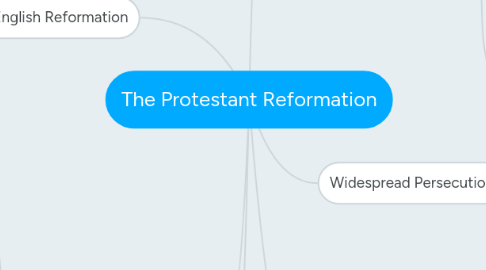
1. Martin Luther
1.1. 95 Thesis
1.1.1. In 1517 Johann Tezel set up a pulpit on the outskirts of Wittenberg, in Germany offering indulgences
1.1.2. Luther thought that it was an outrage
1.1.3. Church had no reason to be doing so Luther thought it was wrong
1.2. Firestorm
1.2.1. he created radical new doctrines
1.2.2. Urge to reject authority of Rome
1.2.3. He was excommunicated and called to diet
1.3. Teachings
1.3.1. Salvation is achieved through faith
1.4. Spreading
1.4.1. Protestant creation - to reject catholic authority
1.4.2. Luther's reforms were an answer of church's ideals
1.4.3. Peasants took it up for social/economic change
1.4.4. during the 1530's and 1540's they reached a peace
2. Switzerland's Reformation
2.1. Ulrich Zwingli
2.2. John Calvin
2.2.1. affect the direction of Reformation
2.2.2. Trained as a priest and a lawyer
2.2.3. 1536 - published a wide spread book
2.2.4. Predestination - The idea that God had long ago determined who would be saved
2.2.5. set up a theocracy or a church based government
2.2.6. Calvinism
3. The English Reformation
3.1. Henry 7th
3.1.1. Tried to denounce luther
3.1.2. hoped pope could annul his marriage so that he can have a son
3.2. Breaking with Church
3.2.1. Henry decided to take over the church
3.2.2. Henry appointed Thomas Craner archbishop of new church.
3.2.3. More was recognized as a saint
3.3. Strenghtening
3.3.1. Between 1536 - 1540 investigated Catholic covenants and monasteries because they were inherently immoral
3.3.2. Henry was strict to strengthen the church
3.4. The Elizabethan
3.4.1. The throne passed to 25-year old Elizabeth had survived court intrigues
3.4.2. As queen had to determine the church of England
3.4.3. Compromise between protestant and catholic practices
4. Background
4.1. Church Abuses
4.1.1. Increasingly Caught Up in World Affairs
4.1.2. Protected Papal states against invasions by secular rulers
4.1.3. Popes led lavish lives, Supported the arts, and hired artists to beautify churches
4.1.4. the church increased fees for services such as marriages and baptism
4.1.5. The Church also sold indulgences or the lessening of time a soul had to spend in purgatory
4.2. Early revolts
4.2.1. John Wycliffe in the 1300's enacted a church wide revolt.
4.2.2. Jan HAus, led a reform movement for which hewas executed.
5. Catholic Reformation
5.1. Council of Trent
5.1.1. The pope called the Council of Trent in 1545. Led by Italian cadinal Carlo Borromeo
5.1.2. reaffirm traditional Catholic views
5.1.3. The council also took stops to end abuses in the Church
5.2. Empowering the Inquistion
5.2.1. Index of Forbidden Books, a list of works considered too immoral or irreligious
5.2.2. Set up more Christian rule
5.3. Founding the Jesuits
5.3.1. Jesuits led the crusade to defend and spread the christian faith
5.3.2. Ignatus
5.4. Teresa of Avilla
5.4.1. symbolized a renewal
5.4.2. reorganize and reform Spanish covents and monasteries.
5.5. Legacy of Catholic Reformation
5.5.1. The majority of Europeans remains Catholic
5.5.2. heated disagreements
6. Widespread Persecution
6.1. witch hunts
6.1.1. Between 1450 and 1750 tens of thousands of women and men died as victems of being accused of being witches
6.1.2. shows negative affects of Christianity
6.1.3. Witches were most likely people like social outcasts
6.2. Persecuting Jews
6.2.1. Jewish Ghetto in 1516
6.2.2. expelled from christian land
